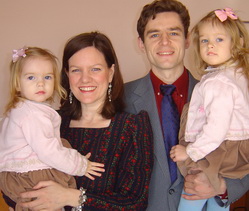Jesus Ultrasound Poster Fuels U.K. Abortion Uproar
Body
Discussion
In case you hadn't heard . . .
Body
Discussion
Remember Randall Terry?
Body
Discussion
Mexican Girl Refuses to Have Abortion, Acknowledges Life of Unborn Child
Body
Discussion
Oklahoma Senate Approves New Abortion Restrictions
Body
Discussion
Mugged by Ultrasound
Body
Discussion
An Interview with Anne Sokol, Part 2
 Read Part 1.
Read Part 1.
Keri: I know that you and Vitaliy both have a lot of ministries going on and you had talked earlier on about your nurse midwife dream and I’d like you to tell the listeners about how the Lord is bringing some of that to fruition in your life now.
Anne: That desire to be a midwife has never really left me. You know it goes under the water for a while but it always resurfaces. It’s like it follows me. About two years ago I started studying to be a doula and childbirth educator. I started studying with a Christian organization called Charis Childbirth. I never really saw how I could do it here because birth here is kind of a mystery for me. I knew women usually have horrible experiences, but it was hard to get any real details and to really know what it looked like. But I started studying this class and through women in my church, I started teaching them childbirth preparation classes. Then I was able to accompany them at their births.
That has been a major eye opener—seeing an actual birth in a birth house. Other women choose to have home births and I have watched how those things happen. The women in my church, and the husbands too, have been so thankful for this ministry that is unique and something that not very many people do. They are so happy to be having happy birth experiences.
Now I’m starting to get clients who are not Christians, and it has been wonderful to have chances to witness to them. Lately, I’ve been working with a couple from Belgium. They are English speakers. Vitaliy and I went out to dinner with them and he presented the gospel to them. It’s neat how childbirth is such an open time in people’s lives. Being educated about it and serving people makes them so open to listen to you about any area of life. It has made people really open to the Lord. I’m really thankful for that.
Discussion
An Interview with Anne Sokol, Part 1
 Keri: So, Anne, I’m excited to talk to you. This is the first time we’ve ever spoken.
Keri: So, Anne, I’m excited to talk to you. This is the first time we’ve ever spoken.
Anne: I’m excited to be here with you!
Keri: I told Anne she was my guinea pig, because I’ve never done an interview on my blog before. Why don’t you tell us just a little bit about how a girl went from Chattanooga and ended up in the Ukraine?
Anne: When I was in high school we had a lot of missionaries come in and out of our church. That was also the time when the wall of Communism fell in Eastern Europe. I’d heard a lot of things about Russia and the former Soviet Union, and my dream became—well, let me back up a little bit. I had a lot of other interests. I was also interested in the pro-life movement and I was involved in that in my hometown. I also wanted to be a nurse midwife. That was my dream.
So I combined all these things, and I wanted to be a missionary in Russia and help women who were having abortions because there was such an astronomical abortion rate in Russia. My dream was to have a home for women who were in crisis pregnancies and I would be their midwife and help them be able to work, go to school, and not have to abort their babies. This was my whole dream.

Discussion